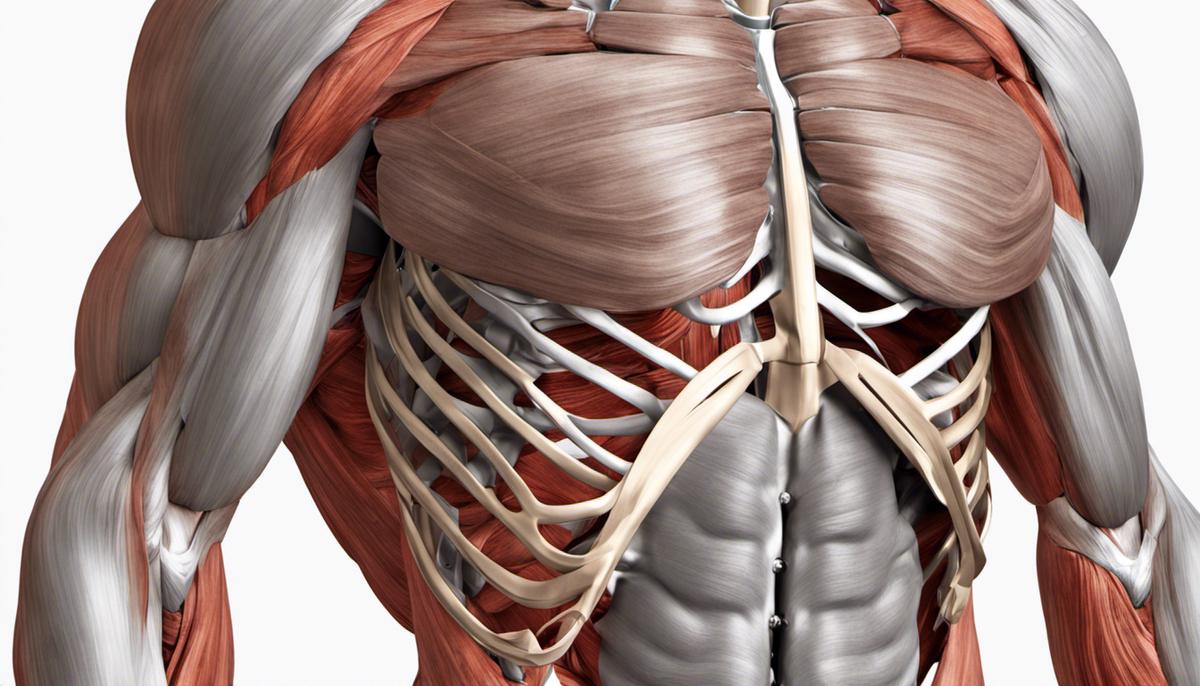The human body is a robust piece of biological machinery, and its upper body, featuring muscle groups such as the chest, shoulders, and triceps, forms a major hub of this system. Pushing exercises, particularly push-ups, are especially effective at strengthening and toning these muscles. These exercises, however, are not just about brute force. They require a deep understanding and mastery of different variations, each with unique benefits and methods of execution. Moreover, the safety and correct form in such workouts are of paramount significance. The purpose of this discussion is to enlighten general public on the fundamentals of the upper body anatomy, the nuances of various push-up variations, and the significance of maintaining proper form and safety during workouts.
Understanding the Anatomy of Upper Body
The Power Behind Upper Body Pushing: Understanding Key Muscle Groups
Once you’re bitten by the weightlifting bug, it’s hard to resist the thrill of seeing how far you can push your strengths, literally! Upper body pushing exercises are an integral part of any weightlifting routine. They encompass a wide array of workouts and target several muscles, turning you into a powerhouse of strength. But what are the key muscle groups involved in these exercises? Let’s take a deep dive into this.
The first and perhaps the most notable group we’ll talk about is the pectoralis major. This powerful pair, fondly referred to as the ‘pecs’, are the large chest muscles. When you think about push-ups or bench presses, it’s the pecs that are doing most of the heavy lifting (pun intended). These muscles benefit hugely from these pushing exercises, which help build bulk, shape, and strength.
Linked inextricably to the pecs are the triceps brachii, the muscles located at the back of your upper arm. Here’s a fun fact: ‘triceps’ means ‘three-headed’ in Latin because this muscle has three distinct sections that work together to extend the forearm. Movements like the overhead press or bench press effectively work these muscles. With meticulous training, you’ll notice increased upper body strength and tone in your arms.
As you plunge deeper into the world of pushing exercises, you’ll realize they also engage the deltoids, or should we say, the staunch soldiers of your shoulders? These rounded muscles cap our upper arms and shoulders and play a crucial role in all upper body pushing activities. From basic push-ups to more sophisticated military presses, the deltoids shine, resulting in broader, well-defined shoulders.
Don’t forget about the muscles that silently support the prime movers – the synergists. The serratus anterior, located along your ribs beneath your pecs, is one such valuable player. It steadies the shoulder blades during the motion, ensuring smooth and safe execution of pushing exercises.
And let’s not underestimate the power of our body’s natural corset, the abdominals. Often overlooked in pushing movements, the abs play an essential stabilizing role. Engaging your abs during pushing exercises not only enhances performance but also contributes to that much-desired core definition.
In the world of weightlifting, knowledge is power. Understanding these muscle groups and how they contribute to upper body pushing exercises can help fine-tune your workout regimen. It allows you to target specific muscle groups more effectively, catering to your personal strength goals.
In summary, upper body pushing exercises are an incredible way to showcase the synergy of your body’s key muscle groups. Keep pressing forward in your fitness journey, and remember, every push counts! Happy lifting!

Mastering Push-Up Variations
The Art of Variation and Intensity: Push-ups Recontextualized
A push-up’s simple yet disciplined form is often taken for granted in the world of fitness. However, this seemingly straightforward exercise actually harbors a myriad of variations catering to different levels of strength and endurance. Adjusting the intensity of push-ups can create a customized workout that not only challenges your body but also elevates your fitness journey towards your specific goals.
One of the easiest push-up modifications is the Knee Push-up, which reduces the weight you’re lifting in the exercise. Instead of your toes, your knees rest on the ground, supporting about 49% of the body’s weight compared to the conventional push-up’s 64%. This reduces stress on the pectoralis major, deltoids, and triceps, making it an excellent starting point for beginners or for warming up.
If you’re seeking to intensify your push-up game, the Spiderman Push-up is a fantastic option. This variation brings in yet another level of core engagement as you bring your knee towards the elbow during each push-up, hence mimicking Spidey’s wall-climbing action. This move involves a greater proportion of synergist muscles, particularly engaging the obliques.
The Diamond Push-up, characterized by the touching of the thumbs and index fingers under the chest, takes the push-up intensity to an even higher level. This position intensifies the tricep involvement by narrowing the hand placement, thus requiring a higher degree of muscular endurance and strength.
For those yearning for an upper body workout that also targets the deltoids extensively, the Pike Push-up is the go-to variation. By raising your lower body and keeping your upper body vertical, the workout shifts focus to the deltoids, replicating a shoulder-press movement.
When considering advanced variations, the One Arm Push-up without a doubt is a testament to one’s upper body strength. By relying on just one arm, the exercise greatly triggers the core stabilizing muscles while still challenging the pectoralis major, triceps brachii, and deltoids substantially.
Intensity can be manipulated not only through these variations but also by adjusting the tempo of reps or incorporating pause reps into the workout. Slowing down your push-up or adding a hold at the bottom recruits more muscle fibers and increases the time under tension, two key factors in strength and muscle gain.
Combining varied push-up variations with tempo and pause alterations can create an overall push-up program loaded with challenges and opportunities for growth. So whether you’re a beginner or a long-time fitness enthusiast, catering to your individual strength and endurance and getting in touch with your inner ‘body mechanic’ can contribute significantly in enhancing the efficiency and effectiveness of your strength training regimen. Now, let’s hit the deck!

Safety and Proper form in Pushing Exercises
When it comes to ensuring proper form during pushing exercises, it’s essential to practice caution for the best possible outcomes. A keen understanding of overall body positioning and movement patterns can bring you closer to your fitness goals while keeping you safe from any potential injuries.
Pay special attention to the alignment of your body when you’re doing any pushing exercise. Incorrect alignment can lead to unnecessary strain on joints and muscles, sabotaging your efforts. When performing push-ups, for instance, a straight line from your head to your heels, akin to a plank position, is much-advised. This engages your glutes and core, promoting stability, and, importantly, reduces the risk of back injury.
Proper hand placement is another crucial aspect that cannot be stressed enough. Generally speaking, having your hands slightly wider than shoulder-width apart offers a great balance between stability and challenge for push-up exercises. This position optimally engages the pecs and triceps without adding undue strain on the shoulder joints. However, hand placement can vary depending on your goals and the variation of the exercise.
Grip strength is another factor that influences the performance of pushing exercises, especially in movements involving weights or resistance bars. A firm and controlled grip helps ensure stability, reduces the risk of accidental slips, and also generates a higher degree of force output. It’s also essential to remember to distribute the weight evenly throughout your hand to prevent undue strain on any particular part.
Elbow alignment is equally crucial during pushing exercises to protect against overuse injuries. The elbows should ideally be tucked into the body at a 45-degree angle during push-ups. This not only targets the pecs and triceps efficiently but is also gentler on the shoulder joints.
Breathing correctly enhances your workout and helps maintain proper form by providing oxygen to your working muscles. In pushing exercises, it’s generally suggested to exhale during the most challenging part of the move — the press or push — and inhale on the way back.
Last, but certainly not least, is the importance of regular form checks and adjustments. Remember, what feels comfortable at the beginning of your fitness journey might not be suitable as you get stronger and more confident. Regularly check your form in the mirror or, better yet, enlist the help of a friend or a trainer. This way, you’ll know which aspects to work on and improve, making sure that you’re practicing pushing exercises with utmost efficiency and safety.
So, as you embark on your path to greater strength and fitness, remember these precautions. They will not only aid you to conquer those challenging push-ups but ensure that you do so in a safe and effective manner. Keep pushing and keep growing! An impressive upper body strength regimen is never too far away if you take the right steps.

Photo by sotheencourager on Unsplash
Pushing exercises for the upper body are not only a journey of physical transformation; they are also a journey of knowledge discovery. To achieve the desired fitness goals, one must appreciate the intricate interplay of chest, shoulder, and triceps muscles during these workouts. Mastering a variety of push-up forms, leveraging their unique benefits, and maintaining safety and correct form are crucial elements of this fitness journey. By gaining a thorough understanding of these facets, fitness enthusiasts can maximize their workout efficiency, safeguard their wellbeing, and pave the path for long-term fitness success.
